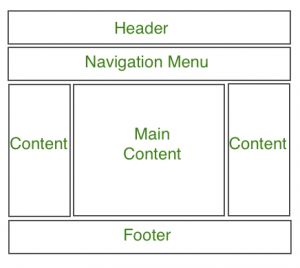CSS Website Layout (original) (raw)
Last Updated : 04 Jan, 2025
CSS website layout divides a webpage into multiple sections like header, navigation bar, content area, and footer, making it easier to organize content and build the site.

**1. Header Section
The header is the top section of a webpage, typically containing the website's name or logo.
html `
<style>
.header {
background-color: green;
padding: 15px;
text-align: center;
}
.header h2 {
color: white;
margin: 0;
}
</style>GeeksforGeeks
`
**In this example:
- The element defines the **header section of the webpage.
- The ****.header CSS** class styles the header with a green background, 15 pixels of padding, and centers the text.
**2. Navigation Menu
The navigation menu is used to create a set of links for easy website navigation.
html `
<style>
.nav_menu {
overflow: hidden;
background-color: #333;
}
.nav_menu a {
float: left;
display: block;
color: white;
text-align: center;
padding: 14px 16px;
text-decoration: none;
}
.nav_menu a:hover {
background-color: white;
color: green;
}
</style>`
**In this example:
- The .nav_menu class defines the style of the navigation menu with a dark background and ensures the links are aligned horizontally.
- The a tag inside .nav_menu defines each link's style, including white text and padding for spacing
**3. Content Section
The content section is used to add content to the page, and you can adjust it according to the screen size.
html `
<style>
.columnA,
.columnB,
.columnC {
text-align: center;
color: green;
}
</style><div class="columnA">Content for Column A</div>
<div class="columnB">Content for Column B</div>
<div class="columnC">Content for Column C</div>`
**In this example:
- The HTML structure defines three content sections, each inside a , which can be further styled or adjusted as needed for responsive layouts.
- The .columnA, .columnB, and .columnC classes style the content areas, aligning the text to the center and coloring it green.
**4. Footer Section
The footer section is placed at the bottom of the webpage and typically contains information like contact details, copyright, or about us.
html `
<style>
.footer {
background-color: green;
padding: 15px;
text-align: center;
}
</style>`
**In this example:
- The .footer class defines the footer section, giving it a green background, padding, and centering the text.
- Inside the footer, there are links for "About," "Career," and "Contact Us," which provide quick access to those sections.
Important Points to Remember
- **The header section contains a website logo, a search bar, and user profile information.
- **The navigation menu includes links to various categories of articles available.
- **The content section is divided into three parts (columns), with left and right sidebars containing links to other articles and advertisements. The main content section holds the current article.
- **The footer at the bottom contains the address, links, contacts, etc.